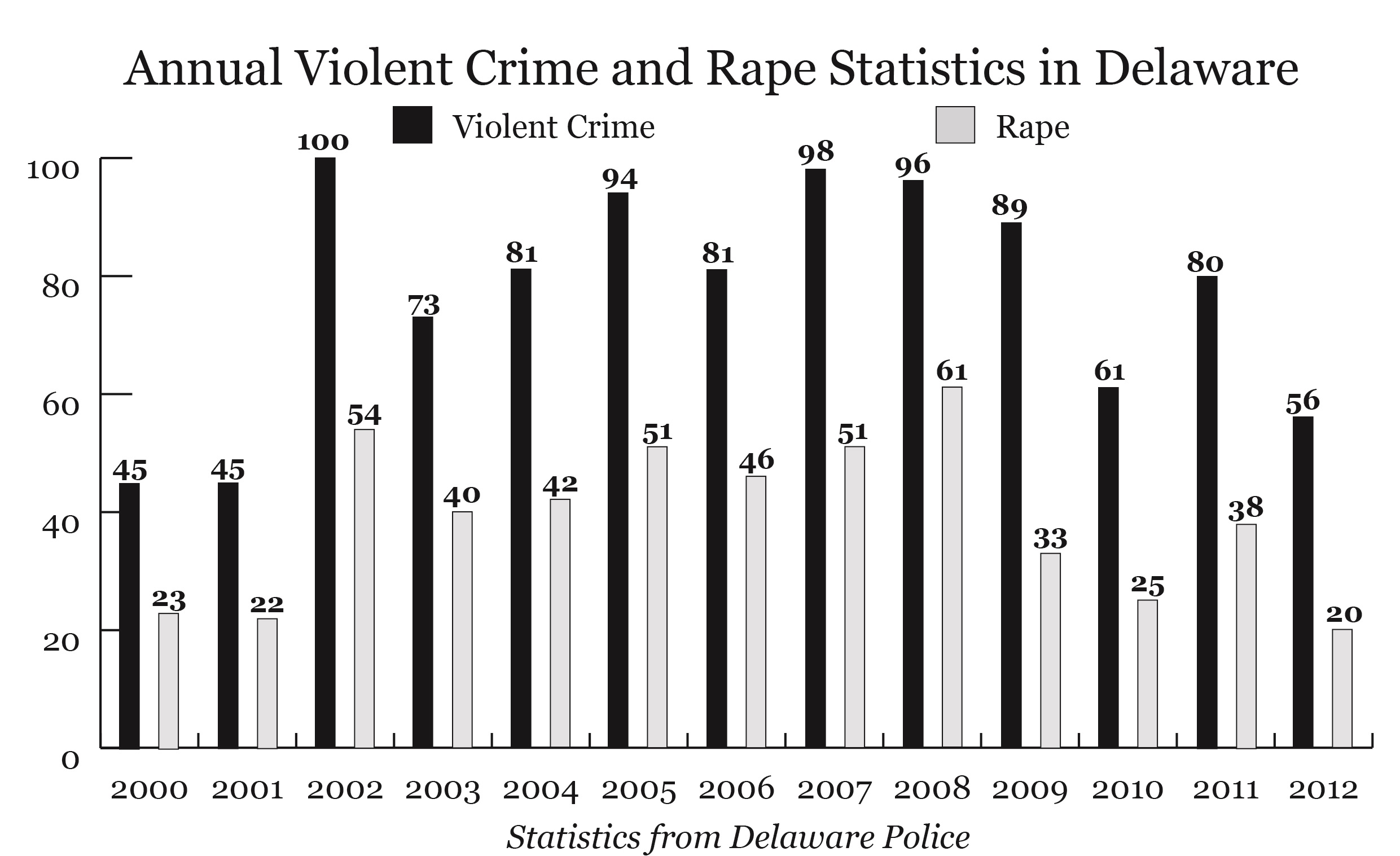How the Delaware community supports its rape survivors
By Spenser Hickey
Managing Editor
506
Delaware Police Department and Federal Bureau of Investigation statistics show that over half the violent crimes reported in Delaware from 2000 to 2012 were rape.
According to criminologist John Durst, Ph.D., this should be a startling statistic. But it’s not one that he’s surprised by – he thinks the numbers likely show that Delaware has a higher level of reporting than other areas.
“We tend to get a lot of reports, and I don’t think that’s because there’s more sexual assault going on in Delaware,” said Delaware Police Chief Bruce Pijanowski.
Former Chief Russell Martin, now Delaware County Sheriff, said he wasn’t alarmed by the data.
“I always believe when your community has confidence in your response to sexual assault, more people are going to report,” he said.
“…We felt confident that people were reporting because they trusted their local police.”
FBI statistics show that from 2000 to 2012, Delaware’s forcible rape reports were 3.3 times the national average and 2.7 times the state average per 100,000 residents. Calculating crimes in terms of 100,000 residents eliminates statistical disparity caused by population size, but the classification of “forcible rape” used by the FBI was narrower than that of Delaware police.
“I would be skeptical of a community that said they didn’t have a sexual assault problem because then I would be concerned whether they’re not encouraging people to come forward and report and investigate and prosecute those matters,” Martin said.
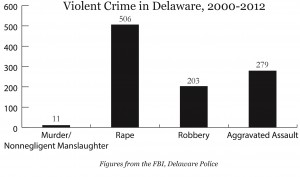
“Given HelpLine intervention, Wesleyan, (and a) pretty educated populace, you’re going to get more people willing to go through the rape kit, whole nine yards, in terms of assaulted persons,” said Durst, an associate professor of sociology at Ohio Wesleyan University (OWU).
Still, any sexual assault case is a horrible experience, he added.
“Just because we’re doing some sort of numerical, statistical comparing, whatever the comparative situation for Delaware, from a victim’s perspective it’s too many.”
– John Durst, Criminologist
The highest year for rape statistics during the period was 2008, when the 61 reports made up 63.54 percent of all violent crimes in the city. Durst said he was hesitant to draw conclusions from the changes in annual rape statistics, though.
337 other sexual assaults – including gross sexual imposition, sexual imposition, sexual battery, unlawful conduct with a minor and attempted rape – were reported to Delaware Police from 2000 to 2012.
“Approximately one in three women experience sexual assault in their lifetimes, so I would say that we’re not necessarily seeing that more sexual assaults are happening in Delaware, rapes specifically, but again higher reporting, which I would consider a positive attribution of our community,” said Richelle Schrock, Ph.D., director of the women’s and gender studies program at Ohio Wesleyan.
“Higher numbers could indicate that the systems are providing a supportive response to encourage victims to come forward and report these crimes,” said Katie Hanna, Executive Director of the Ohio Alliance to End Sexual Violence.
“By creating a culture that believes survivors and promoting a system that holds offenders accountable, we may see more survivors coming forward to report.”
The Reporting Process
“Most sexual assaults are perpetrated by someone known to the victim,” Hanna said. “Whether it’s a partner, family member, neighbor or friend, these factors make reporting challenging.”
In Delaware, the police have a long history of working to make the reporting and investigation process as streamlined as possible for to help survivors, according to Chief Pijanowski and former Chief Martin.
Linda Black, Police Chief from 2001-2004, could not be reached for comment.
Creation of the Sexual Assault Response Team, which brings together law enforcement, hospital staff, HelpLine survivor advocates, the County Prosecutor and the current County Department of Job and Family Services, began in 1993 or 1994, according to Martin, then a Detective-Sergeant with the Delaware Police Department.
Hanna praised this type of team structure.
“By working collaboratively with rape crisis centers, law enforcement, prosecutors and child advocacy centers, we can support survivors on their path to healing.”
– Katie Hanna, Ohio Alliance to End Sexual Violence
“I think that (team) began handling those cases even in a more thorough, sensitive way than they’d been done prior to that,” Martin said.
Pijanowski said that the streamlined system makes it easier for survivors to share their experience and lessen the impact it has.
“Going through the criminal justice system…they just keep reliving it,” he said. Before, the responding officer would take a statement, detectives would ask more detailed questions, as would hospital staff, and then prosecutors would run through questions before the trial.
“There were so many times it was coming up,” Pijanowski said.
When reports are made, Pijanowski said detectives must balance the needs of the survivor and ensuring public safety – a “thin line.”
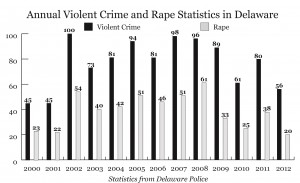
“When you have a sexual assault, you have a survivor of sexual assault who has been victimized in ways that you and I have no comprehension.”
– Bruce Pijanowski, Delaware Police Chief
However in the event of a perpetrator who posed an ongoing threat to the general public’s safety, having the existing support coalition is very beneficial.
“The last thing we want to do is have a survivor come into us and say this happened, I don’t want to prosecute, I don’t want to do anything and we say ‘Well it’s too bad, we’re going to do it,’” he said.
Martin said that the coalition system establishes community trust which leads to more reports due to discussions among survivors.
In one instance, a child survivor described her positive experience working with the police to a friend, who then disclosed that she too had been sexually assaulted, according to Martin.
“You might get an increase in reports but a lot of times we feel that’s because we’ve established a good reputation with the community,” he said.
When reports are made involving child survivors of sexual abuse, detectives have to be very careful, according to Pijanowski.
“(Children) think differently and you have to be really really careful not to plant an idea in their mind, not to lead them or suggest an answer in your question,” he said.
When interviewing children on the exact details of an assault, detectives have to know what the children mean and be sure they know, he said, and so receive specific training to investigate such cases.
When children become involved in the court system as a victim of abuse, neglect or dependency they often receive assistance from Delaware County’s Court Appointed Special Advocates (CASA.)
CASA Coordinator Anne Konarski is also involved in the county-level effort to combat sexual assault.
“We work with all abuse, neglect and dependency cases that come from Delaware County Juvenile Court so we’ll take any sex abuse case that happens, it doesn’t matter if it’s interfamily or not,” Konarski said.
“…It’s just more likely for us to get a case with someone that the person knows because that’s more likely to happen.”
CASA volunteers work to guide children through the civil court process and ensure their basic needs are being met. For sexual assault survivors, this includes ensuring they receive therapy to cope with the trauma.
A “fantastic resource” in knowing how to help a child is the Child Assessment Center in Columbus, Konarski said.
There, children are interviewed by a trained forensic interviewer while a prosecutor and police officer watch from another room so the survivor doesn’t have to repeat the process. They also conduct a complete social-medical history and doctor’s exam to determine the extent of the abuse.
“They do a great evaluation and then we get copies of it (to use in our role as legal advocates),” Konarski said.
Holding the Line
Ohio Wesleyan Professor Richelle Schrock listed the presence of HelpLine of Delaware and Morrow Counties in the center of the city as a resource that increases reporting. HelpLine provides crisis support and referral services and is a rape crisis center, offering services to sexual assault survivors through the Sexual Assault Response Network (SARN).
“Most people know HelpLine from our 24/7 crisis line,” said Nancy Radcliffe, Director of Sexual Assault Services at Delaware HelpLine.
HelpLine supports survivors through the crisis line, providing advocates to those who have reported a sexual assault at an emergency room or police station, holding support groups and retreats and offering information and prevention services.
“Our SARN program really does a wide range of things, and it just kind of depends on where someone is, what kind of help they might want.”
– Nancy Radcliffe, HelpLine of Delaware and Morrow Counties
SARN and HelpLine, as non-profits, rely on grants and donations for funding. One of their donors is Ohio Wesleyan participants in the V-Day movement to end violence against women and girls.
V-Day OWU activists take donations during on-campus performances of Eve Ensler’s “The Vagina Monologues” and donated between $800 and $900 in the past two years, according to co-director Claire Hackett, an OWU student in the class of 2014.
“Although we can promote awareness about sexual assault we are not a resource for survivors and I think raising money is important,” Hackett said.
Radcliffe too agrees that the statistics likely show more reporting occurs in Delaware.
“I think Delaware County has… a team of first responders that work more closely together than in some of the bigger counties,” said Radcliffe, who previously worked in Franklin County and at Ohio State University.
“…Here in Delaware, I would anticipate there would be a higher incidence of people reporting.”
The first responders she referenced include SARN’s survivor advocates, city police and county sheriff’s deputies.
She acknowledged, though, that while those who experience sexual assaults may be more likely to learn of and use services available, general public awareness could be improved.
“I think the support services that exist form a pretty invisible safety net for people, I don’t know that people know that there’s all the great people who can help here out in Delaware,” she said.
Radcliffe also listed several misconceptions about rape and sexual assault that she sees in American society and works to combat in Delaware.
One way HelpLine’s staff works to increase education on and prevent sexual assault is through grant-funded programs in area schools, ranging from preschool to high school to Ohio Wesleyan University, whose students also receive education from Delaware Police through programs started by Police Captain Adam Moore and Public Safety Director Robert Wood.
HelpLine’s programs address violence in general but also include specific focuses on sexual violence.
“What we’ve learned about violence prevention is we need to be talking to everybody,” Radcliffe said.
“We need to be talking to potential perpetrators for sure but also people who witness stuff going on and people who experience it. So we have programs in the elementary school, but we really get into sexual violence prevention more specifically in middle and high schools.”
State-wide activist Katie Hanna mentioned HelpLine’s program specifically, saying it “equips youth with skills to develop healthy relationships, and to stop all forms of sexual violence before they happen, including being an active bystander that interrupts unhealthy behaviors.”
She also said that parents have a role in preventing sexual assault through education.
“Parents should have conversations with their children and teens about healthy relationships, boundaries and consent,” she said.
Their programs on sexual violence don’t make any assumptions regarding possible sexual activity on the part of the students, according to Radcliffe.
“Our goal is not to do sex education but to let people know that any time, this may be on the table, people may be in a situation (involving sexual assault), these are the things you need to know,” she said.
“This is what consent is, this is what coercion is.”
The programs emphasize that consent cannot be given if a person is intoxicated and challenge “rape-supportive ideas”, Radcliffe said.
They also challenge the misperception that survivors are more likely to be assaulted by someone they know than a stranger – the Department of Justice’s 2005 National Crime Victimization Study found that in 73 percent of reported rapes the survivor knew the perpetrator.
“We’re just given messages about the prevention of stranger attacks, so it kind of leaves people unprepared for when it’s someone they know who takes advantage of a situation,” Radcliffe said.
“…A lot of times (people) only think about (sexual assault) as being something that involves a great deal of physical force, so we try to help people understand what it is and once people understand what it is then some good conversations happen.”
Radcliffe added that any form of sexual assault, not just rape, can be incredibly traumatic for the survivor, and how the assault affects them depends on “the individual and their situation.”
“Whether it’s gross sexual imposition, a sexual battery or rape, voyeurism, (it) can be devastating – any of the sex offenses that you look at, the 2907s (Section of sex offenses in the Ohio Revised Code,) for the individual it’s the specific circumstances that seem to resonate with them,” she said.
“…Just because the criminal justice system might charge something as a misdemeanor, it doesn’t mean it hasn’t profoundly affected the person who experienced it.”

56.4 Percent
Another area SARN focuses awareness and prevention efforts on is child sexual abuse, through programs such as Stewards of Children, which trains adults to prevent, recognize and react.
“Adults have more power to interrupt something, and so we try to make sure people have better information than just ‘stranger danger,’” Radcliffe said.
From 2000 to 2008, 56.4 percent of sexual assault survivors in rapes reported to DPD were under 18 on the day the report was made, excluding 21 reports that did not list the survivor’s date of birth.
In Ohio, according to Katie Hanna, more than 60 percent of rape reports involve children and juveniles. Nationally, according to statistics provided by the Rape, Abuse and Incest National Network (RAINN), 44 percent of rape and sexual assault survivors are under 18 and 15 percent are under 12.
In Delaware from 2000 to 2008, 56.4 percent of rape survivors were under 18, as noted, and 28 percent were under 12. The 2010 US Census reported that 23.7 percent of Delaware’s population were minors.
The highest percentage of reporting survivors under 18 during that period was in 2007, when 72.6 percent of those raped were children. There were more rapes of children than any other FBI-defined violent crime that year.
“If that doesn’t make you stop and think ‘What the heck,’ what does?”
– Radcliffe, on statistics on child sexual assault and rape.
HelpLine and SARN work more closely with adult survivors of child sexual assault, she said, and often refer children and their parents or guardians to specialists in Delaware and Franklin County.
“I think our strongest suit is that we’re connected to a lot of people who can help, so it just kind of depends on what the individual wants to do,” Radcliffe said.
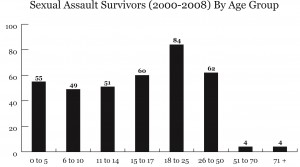
For Hackett, a representative of the V-Day movement to end violence against both women and girls, violence against children is an issue that needs more attention.
“I don’t think when we think of sexual assault we think of children, because that would be even more horrifying,” she said.
“…I think it happens a lot more often than people think and it’s almost like we categorize it into something else, like, ‘Oh, that’s sexual abuse or that’s an abusive family or we say the government will take care of that, will remove the child from that. But it’s so hidden and it’s not talked about.”
She did see it as gaining more attention due to performances such as “The Vagina Monologues” – a series of readings by activist Eve Ensler, founder of the V-Day movement – or “Butterfly Confessions,” a similar piece by Yetta Young that addresses experiences of African-American women.
“People are finally coming out and opening these wounds that they’ve had,” Hackett said.
When children do disclose that they have been or are being assaulted, it’s imperative that they be believed, as should all sexual assault survivors, according to Hanna.
“Children are often threatened by these ‘trusted’ adults to keep secrets,” she said.
“Survivors need to hear that it’s not their fault and they are not to blame for what happened to them, at any age.”
– Katie Hanna, Ohio Alliance to End Sexual Violence
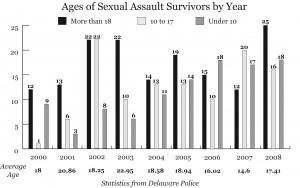
Related – Catching up: Sex crime reporting in Delaware and at Ohio Wesleyan
